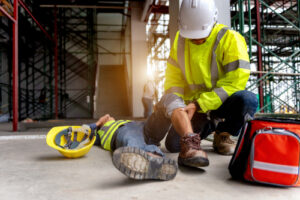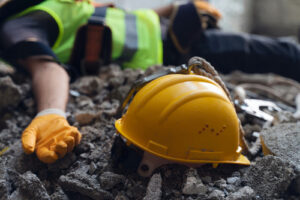Scaffolding Accidents
Scaffolding Accidents
In the world of construction and building maintenance, scaffolding plays a vital role in providing workers with elevated platforms to carry out their tasks safely and efficiently. However, despite stringent safety regulations and precautions, scaffolding accidents occur with alarming frequency. These incidents can result in severe injuries, long-term disabilities, and even fatalities, leaving workers and their families grappling with physical, emotional, and financial challenges. Consulting a construction accident lawyer can provide crucial assistance in navigating the complexities of these incidents.
Here, a scaffolding accident attorney will shed light on the various aspects of scaffolding accidents, from common causes to the legal implications and the role of a scaffolding accident lawyer in securing justice for those affected.
Schedule a Free Initial Consultation Today!
Common Types of Scaffolding Accidents
Scaffolding accidents can take many forms, each with its own set of causes and potential consequences. Understanding these different types of incidents is key to developing effective prevention strategies and recognizing potential hazards in the workplace.
and potential consequences. Understanding these different types of incidents is key to developing effective prevention strategies and recognizing potential hazards in the workplace.
Falls from height are perhaps the most well-known and feared scaffolding accident. These can occur due to unstable platforms, lack of proper guardrails, or workers losing their balance while performing tasks at elevated heights. Scaffold collapse is another serious concern, which can happen when scaffolding is improperly constructed, overloaded, or subjected to external forces such as high winds or vehicle impacts. Such collapses can potentially injure workers on the scaffold and those on the ground below.
Falling objects pose a significant risk in scaffolding accidents. Tools, materials, or debris falling from scaffolding can cause serious injuries to workers or passersby below. This type of accident highlights the importance of proper toe boards and debris netting. Electrocution is another hazard associated with scaffolding work, particularly when scaffolds are erected near power lines or electrical equipment. Workers may be at risk of electrocution through direct contact with live wires or through the scaffolding itself conducting electricity.
Trips and slips on scaffolding are common occurrences that can lead to serious injuries. Uneven surfaces, wet conditions, or obstacles on scaffolding planks can cause workers to lose their footing, potentially resulting in falls or other injuries. Additionally, the physical demands of working on scaffolding, often in awkward positions or with heavy materials, can lead to overexertion and strain injuries over time.
Causes of Scaffolding Accidents
Scaffolding accidents rarely occur due to a single factor. Instead, they are often the result of a combination of circumstances and oversights that collectively create unsafe conditions.
Inadequate training is a significant contributor to scaffolding accidents. Workers who lack proper instruction in scaffold erection, use, and safety procedures are more likely to make mistakes or take unnecessary risks that can lead to accidents. This underscores the importance of comprehensive training programs for all personnel involved in scaffolding work.
Poor scaffold design or construction is another major cause of accidents. Scaffolding not designed or constructed to support the required loads or withstand environmental conditions can fail, leading to collapses or instability. This highlights the need for qualified professionals to oversee the design and erection of scaffolding structures.
The lack of proper safety equipment also contributes to many scaffolding accidents. Failure to provide or use appropriate personal protective equipment (PPE), such as harnesses, hard hats, and non-slip footwear, can increase the risk and severity of accidents. Employers must ensure that all necessary safety equipment is available and that workers are trained in its proper use.
Insufficient maintenance and inspections contribute to the deterioration of scaffolding over time, potentially leading to accidents. Regular inspections and maintenance of scaffolding are necessary to identify and address potential hazards before they lead to incidents. This includes checking for signs of wear, damage, or instability and promptly addressing any issues discovered.
scaffolding over time, potentially leading to accidents. Regular inspections and maintenance of scaffolding are necessary to identify and address potential hazards before they lead to incidents. This includes checking for signs of wear, damage, or instability and promptly addressing any issues discovered.
Overloading is a common cause of scaffolding failures. Exceeding the weight capacity of scaffolding by placing too many workers or materials on the structure can lead to collapse or instability. It’s imperative that workers are aware of weight limits and that these limits are strictly adhered to at all times.
Environmental factors can significantly impact scaffolding safety. Adverse weather conditions such as high winds, rain, or ice can make scaffolding slippery or unstable, increasing the risk of accidents. Proper planning and monitoring of weather conditions are essential to ensure safe working conditions on scaffolding.
Inadequate fall protection is a major contributor to scaffolding accidents involving falls from height. The absence of proper guardrails, personal fall arrest systems, or safety nets can result in catastrophic falls. Ensuring appropriate fall protection measures are in place and properly maintained is crucial for worker safety.
Poor communication can lead to misunderstandings and accidents on scaffolding. Failure to effectively communicate safety protocols, hazards, or changes in work conditions can result in workers being unaware of potential dangers or proper procedures. Clear and consistent communication among all parties involved in scaffolding work is essential for maintaining a safe work environment.
Rushing to complete tasks or meet deadlines can compromise safety on scaffolding. When workers feel pressured to work quickly, they may cut corners or neglect safety procedures, increasing the risk of accidents. It’s important for employers to foster a culture of safety that prioritizes proper procedures over speed.
The Impact of Scaffolding Accidents on Workers and Families
Scaffolding accidents can have devastating consequences for workers and their families. The physical injuries resulting from these incidents can range from minor cuts and bruises to severe trauma, permanent disabilities, and even fatalities. Common injuries include fractures, spinal cord damage, traumatic brain injuries, and internal organ damage. These injuries often require extensive medical treatment, prolonged rehabilitation, and, in some cases, lifelong care.
The psychological impact of scaffolding accidents should not be underestimated. Survivors may experience post-traumatic stress disorder (PTSD), anxiety, depression, and other mental health issues as a result of their traumatic experiences. The fear of returning to work, especially in similar high-risk environments, can be overwhelming and may lead to career changes or early retirement.
Financially, scaffolding accidents can be ruinous for workers and their families. Medical expenses, lost income, and the potential loss of future earning capacity can create significant financial strain. In cases of permanent disability or fatality, families may face long-term economic hardship, struggling to cover basic living expenses and maintain their quality of life.
The ripple effects of scaffolding accidents extend beyond the injured worker to impact entire families. Spouses may need to take on additional caregiving responsibilities or increase their work hours to compensate for lost income. Children may experience emotional distress and changes in family dynamics. The strain on relationships and family cohesion can be substantial, potentially leading to long-term social and emotional consequences.
Legal Considerations in Scaffolding Accident Cases
When a scaffolding accident occurs, various legal considerations come into play. Understanding these aspects is key for injured workers and their families seeking compensation and justice. The legal landscape surrounding scaffolding accidents can be complex, involving multiple parties and overlapping areas of law.
Workers’ compensation is often the first line of recourse for employees injured in scaffolding accidents. This system provides benefits to cover medical expenses and a portion of lost income, regardless of fault. However, workers’ compensation benefits may be limited and may not fully address the long-term impacts of severe injuries.
In some cases, injured workers may have grounds for a personal injury lawsuit in addition to or instead of a workers’ compensation claim. This typically occurs when a third party, such as a scaffold manufacturer or a subcontractor, is at fault for the accident. These lawsuits can potentially provide more comprehensive compensation, including damages for pain and suffering, which are not covered by workers’ compensation.
Product liability claims may arise if the scaffolding accident was caused by defective equipment or materials. In such cases, the manufacturer, distributor, or retailer of the faulty product may be held liable for the resulting injuries. These claims require demonstrating that the product was defective and that the defect directly contributed to the accident.
Construction site owners and general contractors may also be legally responsible for scaffolding accidents under premises liability or general negligence theories. They have a duty to maintain a reasonably safe work environment, and failure to do so can result in liability for accidents that occur on their property or under their supervision.
In cases of fatal scaffolding accidents, surviving family members may pursue wrongful death claims. These lawsuits seek compensation for the family’s losses, including loss of financial support, loss of companionship, and funeral expenses.
The Role of a Scaffolding Accident Lawyer
A scaffolding accident lawyer plays a major role in helping injured workers and personal intheir families navigate the legal aftermath of these incidents.
One of the primary functions of a scaffolding accident lawyer is to conduct a thorough investigation of the incident. This involves gathering and analyzing evidence, interviewing witnesses, reviewing safety records, and consulting with industry experts. The goal is to establish the facts of the case and identify all potentially liable parties.
Scaffolding accident lawyers also assist clients in navigating the workers’ compensation system. An attorney can ensure that claims are properly filed, all eligible benefits are pursued, and any disputes with insurance companies are effectively resolved. In cases where workers’ compensation benefits are insufficient to cover the full extent of the injuries, these lawyers can explore additional avenues for compensation.
When third-party liability is identified, scaffolding accident attorneys can initiate personal injury lawsuits on behalf of their clients. This process involves preparing and filing legal documents, engaging in settlement negotiations, and, if necessary, representing the client in court. Your scaffolding accident attorney’s goal is to secure fair compensation that addresses immediate medical expenses, lost income, long-term care needs, pain and suffering, and other damages.
Scaffolding accident lawyers also advocate for their clients throughout the legal process. They provide guidance on important decisions, explain legal concepts in understandable terms, and offer emotional support during what is often a challenging and stressful time for injured workers and their families.
Furthermore, these legal professionals promote workplace safety by holding negligent parties accountable. Through their work, they contribute to raising industry standards and encouraging compliance with safety regulations, potentially preventing future accidents.
The Ongoing Importance of Human Factors in Scaffolding Safety
Despite technological advancements, human factors play a pivotal role in scaffolding safety. The attitudes, behaviors, and decisions of workers, supervisors, and management have a significant impact on overall safety outcomes.
scaffolding safety. The attitudes, behaviors, and decisions of workers, supervisors, and management have a significant impact on overall safety outcomes.
Fostering a strong safety culture is important in preventing scaffolding accidents. This involves creating an environment where safety is valued at all levels of the organization, from top management to front-line workers. A robust safety culture encourages open communication about safety concerns, promotes proactive hazard identification, and empowers workers to stop work if they perceive unsafe conditions.
Leadership commitment to safety is a key driver of positive safety outcomes. When management visibly prioritizes safety over production pressures, it sets the tone for the entire organization. This commitment should be demonstrated by providing adequate resources for safety initiatives, consistently enforcing safety rules, and recognizing and rewarding safe behaviors.
Effective communication remains a cornerstone of scaffolding safety. Clear, consistent messaging about safety expectations, potential hazards, and proper procedures is essential. This includes formal training sessions, regular toolbox talks, safety briefings, and ongoing dialogue between workers and supervisors about safety-related issues.
Human factors engineering, which considers how people interact with equipment and environments, is increasingly being applied to scaffolding design and use. This approach aims to create scaffolding systems that are intuitive to use, minimize the potential for human error, and accommodate the physical and cognitive capabilities of workers.
Addressing fatigue and stress is another important aspect of managing human factors in scaffolding safety. Long work hours, challenging physical conditions, and high-pressure environments can all contribute to fatigue and stress, potentially increasing the risk of accidents. Implementing appropriate work-rest schedules, providing adequate breaks, and promoting overall worker well-being are important strategies for mitigating these risks.
Continuous learning and improvement should be embedded in scaffolding safety practices. This includes conducting thorough investigations of all incidents and near-misses, sharing lessons learned across the organization, and regularly updating safety procedures based on new information and best practices.
Injured? Reach Out to a Scaffolding Accident Attorney
If you or a loved one has been affected by a scaffolding accident, it’s important to understand your rights and options. A scaffolding accident attorney can provide the guidance and support you need to seek fair compensation for your injuries and losses.
Don’t face this challenging situation alone. Contact a qualified scaffolding accident lawyer today for a confidential consultation.
Remember, time is often a factor in these cases due to statutes of limitations. The sooner you reach out for legal assistance, the better positioned you’ll be to build a strong case and pursue justice.
Take the first step towards recovery and justice. Contact a construction accident lawyer now to discuss your case and learn how they can help you move forward.


